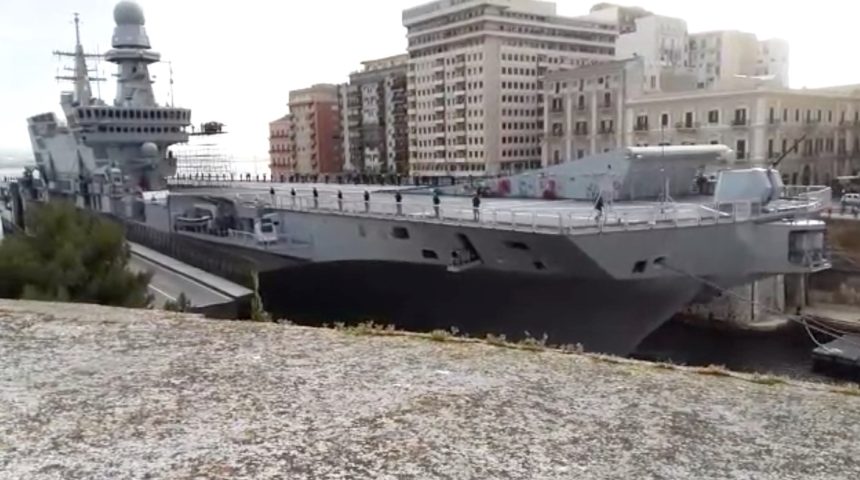The Italian aircraft carrier has left the Arsenal at Taranto after modernization works and is almost ready for her next chapter: F-35B integration tests.
Early in the morning on May 6, 2020, the Italian Navy Cavour aircraft carrier left the Arsenale Militare Marittimo (Maritime Military Arsenal) of Taranto, Italy.
The 27,000-ton ship had entered the Arsenal in December 2018. On Jul. 6, 2019, the ship entered the Arsenal’s “Edgardo Ferrati” drydock to start the maintenance and modernization works required to accommodate and operate the F-35B Lightning II aircraft: it was the largest ship to enter the drydock since WWII. The aircraft carrier left the drydock in November 2019, after completing the careening works started on Jul. 20, 2019, but remained in the basin for the works required to integrate the new stealth jet: part of the works focused on the flight deck to prepare it to the severe thermo-mechanical impact of the F-35’s engine exhaust plumes on the non-skid surface and structure of ship.
The Cavour has left the Arsenal after about 90 percent of the overhaul activities have been completed: the rest of the “restyling” will be carried out in the “Mar Grande” naval station. The Arsenal is located in the Mar Piccolo Basin, an inner, semi-enclosed basin with lagoon features divided by two rocky promontories into two inlets, called First Inlet (Primo Seno) and Second Inlet (Secondo Seno). The ship-yard of the Italian Navy with its dry-docks is located in the First Inlet of the Basin. The Mar Piccolo is connected to the Mar Grande through two channels, one of those is the Navigabile channel that ships use to enter or exit the Arsenal.
The pass through the Navigabile channel was filmed by several people who shared some really awesome clips across social media. Among all the footage available, the videos below, we received from Raffaele Fusilli, are particularly interesting as they give a clear idea of the size of the ship as she crosses the tight canal:
Here are some other videos posted to Youtube:
Once the modernization works are completed, the Italian aircraft carrier will undertake a preparatory training before sailing to the U.S. where the ship will conduct trials with the F-35B STOVL (Short Take Off Vertical Landing) variant of the Joint Strike Fighter on board. The Italian Navy received its first two jets in 2018 and 2019. These were transferred to MCAS Beaufort, home of the U.S. Marine Corps F-35B pilot training.
The trials represent one of the steps required to achieve the IOC (Initial Operational Capability) of the aircraft carrier with the new jet.
For a more detailed breakdown of the Italian Navy F-35B program you can find more details in this article, published here at The Aviationist in February. Here’s an excerpt:
The Italian Government is currently procuring 90 F-35s, 60 of those are F-35As and the remaining 30 ones are F-35Bs. Out of those 30 F-35Bs, 15 will go to the Navy and 15 to the Air Force. The Lightning II will replace the Navy’s ageing AV-8B+ Harrier II and will be embarked on the Cavour aircraft carrier and the new LHD Trieste. It is not completely clear, however, where the F-35s will be land-based.
The Gruppo Aerei Imbarcati “Wolves”, which will operate the F-35B within the Navy, is currently based in Grottaglie, close to the naval port of Taranto, home to the Cavour aircraft carrier [and to the Trieste landing helicopter dock (LHD), in the future]. However, according to some reports, the Italian Defense Chief of Staff has already identified Amendola Air Base, the MOB (Main Operating Base) of the F-35A within the ItAF (about 100NM northwest of Grottaglie), as the national MOB for both the CTOL (Convetional Take Off and Landing) and STOVL (Short Take Off Vertical Landing) versions of the Lightning II. This should prompt the relocation of the “Wolves” to Amendola, creating a joint Air Force/Navy flight line with common logistics and training, even though it would practically mean that the entire force would mostly be under Air Force control.
With both Italian Air Force’s and Navy’s F-35Bs based at Amendola AB, the Italians would replicate the British model that sees RAF Marham as MOB for a jointly manned “Lightning Force” made of Air Force (with the 207 and 617 squadrons) and Navy (with the 809 Naval Air Squadron that will be re-established in 2023) personnel, sharing aircraft, equipment and support infrastructures. The creation of an Italian Joint Lightning Force makes much sense: aircrew training, maintenance and at least part of the logistics could be concentrated in one place, with some significant savings. And if the selected base is Amendola, the Italian Joint Force could leverage at least some of the infrastructures built there to accommodate the Lightning. Indeed, preparation to host the F-35 in Amendola started in 2012 and today the “F-35 citadel” is literally a “base inside the base” with modern shelters and buildings located inside an access-controlled restricted zone created to isolate the 13° Gruppo’s area from the rest of the base. It must not be forgotten tha the advent of the F-35 has induced the Italian MoD to adopt tighter security measures than those in place before the arrival of a 5th generation technology and this becomes pretty evident if you think that all the photographs taken inside Amendola, must be reviewed one by one by security personnel so that no sensitive detail would be leaked. For sure, making Grottaglie ready for the F-35B would cost a lot of money and time, considered that the works to prepare the base for the Joint Strike Fighter were halted a couple of years ago.
[…]
Whatever, the Cavour is almost ready to receive the F-35B and its air group.









